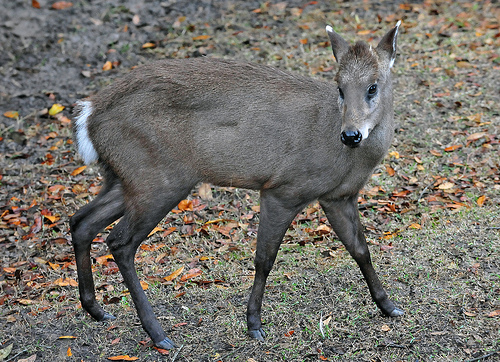Tufted deer are masters at fleeing with a hair to spare.
- Tufted deer are a species of small mammal, native to the mountainous forests of southern to central parts of China in Asia, and they are also thought to exist in northern parts of Myanmar.
- The scientific name of the tufted deer is Elaphodus cephalophus and it is from the family Cervidae, the family of deer.
- Tufted deer grow to be 50 to 70 centimetres (1.6 to 2.3 feet) in height to the shoulder, and weigh 17 to 50 kilograms (37 to 110 pounds).
- The rough hair coat of a tufted deer is mainly dark brown to dark grey in colour; with white on the underside, on part of the ears and mouth; and the deer has a tuft of hair on the front of its head, that hides the short antlers that a male has.
- Male tufted deer have a pair of long, protruding, tusk-like teeth, reaching up to a length of 2.6 centimetres (1 inch), that they use to defend their territory.
Tufted Deer
Image courtesy of Heather Paul/Flickr
- Female tufted deer produce one to two young each year, which are expected to reach an age of around 10 to 12 years in the wild; and the deer tend to live alone, or in pairs.
- Tufted deer tend to be shy, and avoid being seen by camouflaging themselves in their natural surroundings or hiding among the foliage, however they bark when disturbed.
- The diet of tufted deer consists primarily of grass, twigs, fruit and leaves; while their predators are primarily dholes, leopards and humans.
- Tufted deer are listed as near threatened, with consideration to relist the deer as vulnerable, due to over-hunting and habitat loss, that is causing significant population decline.
- To escape from predators, tufted deer point the white underside of their tail upwards, and then move it back down to display the brown side, and as such, create confusion.
Bibliography:
Harris R & Jiang Z, Elaphodus cephalophus, 2015, The IUCN Red List of Threatened Species, http://www.iucnredlist.org/details/7112/0
Lundrigan B & Oas R, Elaphodus cephalophus, 2003, Animal Diversity Web, http://animaldiversity.org/accounts/Elaphodus_cephalophus/
Tufted Deer, 2016, Wikipedia, https://en.wikipedia.org/wiki/Tufted_deer








